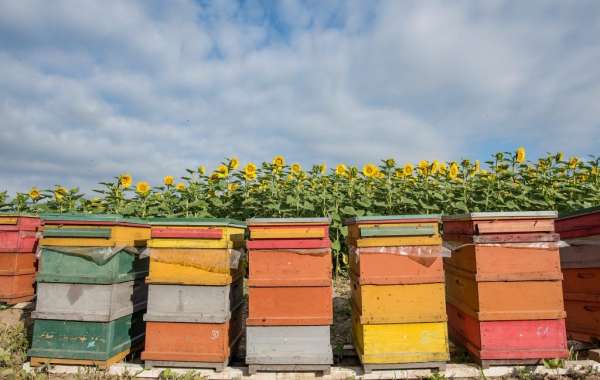Rainy summers can be a blessing for gardens but a challenge for beekeepers. For beginners, managing beehives during extended wet weather is a learning experience that requires careful attention to hive health, honey production, and proper gear. In this guide, we explore essential tips for navigating rainy seasons and discuss why investing in the best beekeeping suits and the best beekeeping veils can make all the difference in keeping your hives thriving.
The Challenges of Rainy Summers for Beekeeping
Rainy weather brings higher humidity, reduced nectar flow, and increased risks of mold and pests in hives. Bees also become more prone to stress when they are unable to forage regularly. These challenges can hinder honey production and compromise hive health. For beginner beekeepers, understanding these hurdles is the first step toward successful hive management.
Why Proper Beekeeping Gear Matters in Wet Conditions
During a rainy summer, beekeepers must be well-prepared with the right equipment. Proper beekeeping gear not only ensures your safety but also allows you to conduct hive inspections and maintenance efficiently in less-than-ideal weather. Investing in lightweight and waterproof bee suits is particularly crucial for beginners.
The best bee suits for beginners should offer a balance of protection and comfort. Look for breathable fabrics that keep you cool during inspections and a hooded veil to shield your face from agitated bees. Waterproof bee suits are especially useful for rainy conditions, as they prevent discomfort and keep you focused on your work.
Managing Hive Moisture Levels: Keeping Honey Safe and Dry
Excess moisture is a common issue during rainy seasons. High humidity can lead to condensation inside the hive, which can dampen honey and create an environment conducive to mold growth. Here are some practical tips for controlling moisture levels:
Improve Hive Ventilation: Ensure your hives have proper ventilation by using screened bottom boards or adding ventilation holes.
Tilt the Hive Slightly: Tilting the hive slightly forward allows rainwater to drain off the roof and prevents pooling.
Use Moisture Absorbers: Place moisture-absorbing materials like burlap or cedar shavings inside the hive to reduce dampness.
Protecting your hives from moisture not only safeguards honey stores but also promotes the overall health of your colony.
Inspecting Beehives During Rainy Weather: Tips for Success
Hive inspections are essential during rainy seasons to monitor bee activity and check for potential issues like pests or diseases. However, wet conditions require extra caution. Follow these tips for effective hive inspections:
Choose the Right Time: Conduct inspections during breaks in the rain when bees are less likely to be stressed.
Wear Waterproof Gear: Equip yourself with breathable beekeeping suits designed for wet weather. This ensures you stay comfortable and focused.
Minimize Disturbance: Limit the time you spend inspecting the hive to avoid exposing bees to cold and damp conditions.
For beginners, the best beginner beekeeping suits with integrated veils and elastic cuffs provide optimal protection during these inspections.
How to Choose the Best Bee Suits for Beginners in Rainy Conditions
Not all bee suits are created equal, and choosing the right one can significantly impact your beekeeping experience. Here’s what to look for when selecting a suit for rainy conditions:
Waterproof Material: Opt for suits made with water-resistant fabrics to keep you dry during wet weather.
Breathability: Ensure the suit allows airflow to prevent overheating during inspections.
Durable Zippers and Seams: High-quality zippers and reinforced seams prevent water leakage and ensure longevity.
Lightweight Design: Lightweight suits are easier to move in and reduce fatigue during long sessions.
Brands that specialize in beginner-friendly gear often offer suits tailored to these needs, making it easier to get started with confidence.
Feeding Honeybees When Nectar Flow is Limited
Rainy weather often limits nectar availability, leaving bees without adequate resources to sustain their colony. To support your hive during these periods, consider supplementary feeding options:
Sugar Syrup: Provide a 1:1 sugar-water solution to mimic nectar.
Protein Patties: Offer pollen substitutes to boost nutrition.
Monitor Feeding: Regularly check feeders to ensure bees are consuming the supplements and adjust as needed.
Feeding honeybees during rainy summers can prevent colony starvation and maintain their strength until natural resources become available again.
Monitoring Hive Health After a Wet Season
After prolonged rainy periods, it’s crucial to assess the health of your hive. Look for signs of stress, such as reduced brood activity, low honey stores, or increased pest presence. Conduct a thorough inspection, focusing on:
Comb Integrity: Check for moldy or water-damaged combs that may need to be replaced.
Pest Control: Look for pests like small hive beetles that thrive in damp conditions.
Queen Health: Ensure the queen is active and laying eggs to support colony recovery.
Proper post-season care can set your hive up for success in the drier months ahead.
Conclusion
Managing beehives through a rainy summer can be challenging, but with the right approach and equipment, it’s an opportunity to learn and grow as a beekeeper. Prioritize hive health by addressing moisture issues, supporting your bees with supplementary feeding, and conducting regular inspections. And don’t forget to invest in the best beekeeping suits, veils, and other essential beekeeping gears to keep yourself safe and comfortable throughout the season.
With preparation and care, you can turn rainy summers into a season of success, ensuring your bees stay healthy and productive while you gain valuable experience in your beekeeping journey.




